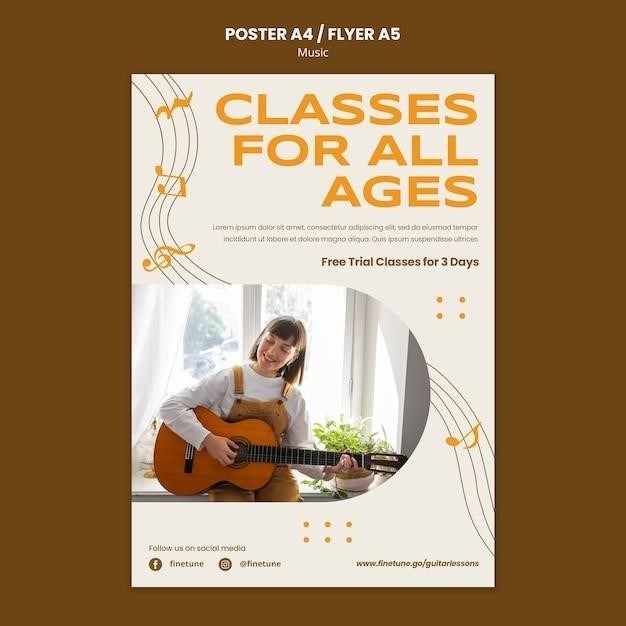Suzuki Violin Method Vol 6⁚ A Comprehensive Guide
Suzuki Violin School ‒ Volume 6 (Revised)⁚ Violin Part ― Ebook written by Dr. Shinichi Suzuki. Read this book using Google Play Books app on your PC, android, iOS devices. Download for offline reading, highlight, bookmark or take notes while you read Suzuki Violin School ‒ Volume 6 (Revised)⁚ Violin Part.
Introduction
Suzuki Violin School, Volume 6, is a crucial step in the Suzuki Violin Method, guiding students through increasingly complex musical concepts and repertoire. This volume marks a significant transition for young violinists, introducing them to more challenging pieces and advanced techniques. It is designed to build upon the skills and knowledge acquired in previous volumes, fostering a deeper understanding of music and refining their technical abilities. This comprehensive guide will delve into the features, contents, and resources available for Suzuki Violin School, Volume 6, providing insights for both students and teachers.

What is the Suzuki Violin Method?
The Suzuki Violin Method, pioneered by Dr. Shinichi Suzuki, is a unique approach to music education that emphasizes the development of musical talent through immersion and repetition. It draws inspiration from the natural learning process of language acquisition, believing that every child can learn to play music with proper guidance and consistent practice. The method focuses on listening, observation, and repetition, encouraging students to learn by ear and develop a deep understanding of musical concepts through constant exposure to music. The Suzuki Violin Method provides a structured curriculum that progresses gradually, building upon fundamental skills to cultivate musicianship and a lifelong appreciation for music.
The Importance of Volume 6
Suzuki Violin School, Volume 6 marks a significant milestone in the Suzuki Violin Method, introducing students to a new level of musical complexity and sophistication. This volume serves as a bridge between the earlier stages of learning and the more advanced repertoire that awaits in later volumes. It introduces students to challenging pieces by renowned composers like Handel and Corelli, fostering their musical maturity and technical proficiency. Volume 6 builds upon the fundamental skills acquired in previous volumes, encouraging students to refine their bowing techniques, develop their musical expression, and cultivate a deeper understanding of musical form and structure. It is a crucial step in the Suzuki Violin Method, setting the stage for even greater musical growth and exploration.
Key Features of Suzuki Violin School, Volume 6
Suzuki Violin School, Volume 6 offers a rich tapestry of musical experiences, encompassing a diverse range of musical styles and challenges. The volume features a carefully curated selection of pieces that expand the student’s musical horizons, fostering a deeper appreciation for classical music. These pieces are not only technically demanding but also musically engaging, encouraging students to explore a wider range of musical expressions and techniques. Volume 6 introduces concepts like double stops, vibrato, and more complex bowings, pushing students to refine their technical skills and develop a more nuanced understanding of musical phrasing and interpretation. The pieces in Volume 6 serve as stepping stones towards greater musical mastery, preparing students for the challenges and rewards of more advanced repertoire.
New Edition and Revisions
The revised edition of Suzuki Violin School, Volume 6 reflects the ongoing commitment to refining and enhancing the Suzuki method. This updated edition incorporates valuable insights from the International Violin Committee, resulting in a refined musical experience. The music has been meticulously reviewed and edited, ensuring that the pieces are presented with clarity and accuracy. These revisions cater to the evolving needs of Suzuki students, providing a more polished and accessible learning experience. The revised edition not only addresses technical aspects but also incorporates pedagogical enhancements, offering a more comprehensive and engaging approach to learning. These revisions further solidify Volume 6 as an essential resource for Suzuki violin students and teachers, promoting a deeper understanding and appreciation of the musical repertoire.
Included Pieces
Suzuki Violin School, Volume 6 presents a curated selection of classical masterpieces that challenge and inspire young violinists. The repertoire features a diverse range of styles and composers, introducing students to the rich world of classical music. Among the notable pieces included are⁚ “La Folia” by Arcangelo Corelli, arranged by Shinichi Suzuki, Sonata No. 3 in F Major, HWV 370 by George Frideric Handel, “Allegro” by Joseph-Hector Fiocco, “Gavotte” by Jean-Philippe Rameau, and Sonata No. 4 in D Major, HWV 371 by George Frideric Handel. These pieces showcase the technical and musical breadth of the Suzuki method, encouraging students to explore intricate melodies, dynamic contrasts, and expressive nuances. The carefully chosen selections in Volume 6 provide a solid foundation for advanced violinists, preparing them for future musical endeavors.
Available Formats and Resources
The Suzuki Violin Method, Volume 6 is readily accessible in various formats to cater to the diverse needs of students and educators. For those seeking a digital experience, digital editions are available, allowing for convenient access on electronic devices. These editions often include interactive features such as annotations and highlighting, enhancing the learning process. Physical copies of the book are also readily available, providing a traditional and tactile learning experience. These copies can be purchased from reputable music retailers and online marketplaces. The availability of both digital and physical formats ensures that learners can choose the option that best suits their preferences and learning style.
Digital Editions
For those who prefer the convenience and portability of digital resources, Suzuki Violin School, Volume 6 is available in digital format. This allows for easy access on a variety of devices such as smartphones, tablets, and computers. Digital editions often come with features that enhance the learning experience, such as interactive annotations, highlighting capabilities, and the ability to adjust font sizes for optimal readability. These features make it easier for students to engage with the material and make notes, promoting a more interactive and personalized learning journey.
Physical Copies
Physical copies of Suzuki Violin School, Volume 6 offer a traditional and tactile learning experience. These printed books provide a familiar and comfortable format for many learners, allowing for easy navigation and highlighting. Physical copies are often preferred for students who enjoy the feeling of turning pages and writing in their books. They also provide a sense of permanence and ownership, making them a valuable resource for years to come. Physical copies can be found in music stores, online retailers, and through authorized Suzuki retailers;
Audio Downloads and Recordings
Audio downloads and recordings are an essential component of the Suzuki Violin Method. They provide students with the opportunity to hear the pieces played by experienced musicians, fostering aural learning and developing a strong musical ear. These recordings serve as models for intonation, phrasing, and dynamics, guiding students towards accurate and expressive performance. Audio downloads can be purchased from reputable online retailers such as Alfred Music, Amazon Music, and iTunes. Additionally, the International Suzuki Association provides resources for finding recordings and other materials.
Practice Tips and Techniques
Effective practice is crucial for success in the Suzuki Violin Method. Volume 6 presents more challenging pieces, requiring focused and deliberate practice. Begin by listening to the recordings attentively, focusing on the nuances of the music. Break down the pieces into smaller sections, practicing each part slowly and accurately. Pay attention to intonation, bow control, and phrasing. Use a metronome to maintain a steady tempo and develop rhythmic precision. Regular practice sessions, even if they are short, are more beneficial than infrequent long sessions; Don’t hesitate to seek guidance from a qualified Suzuki teacher for personalized feedback and support.
Suzuki Violin School, Volume 6, marks a significant milestone in the Suzuki Violin Method journey. It introduces students to a repertoire of challenging yet rewarding pieces, fostering their musical growth and technical proficiency. By embracing the principles of the Suzuki Method, including consistent practice, attentive listening, and a supportive learning environment, students can unlock the full potential of Volume 6. This volume serves as a testament to the enduring legacy of Dr. Suzuki, inspiring generations of violinists to explore the world of music with passion and dedication.
